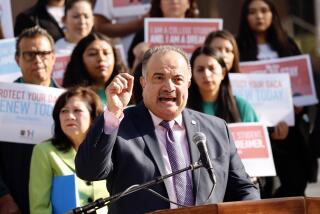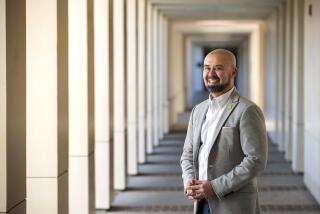Quest Beyond the Campus
For the first five years on the job, Ruth J. Simmons buried herself in the business of running Smith College. The new president limited her off-campus visits to meeting with Smith alumnae and touring Eastern prep schools filled with brainy girls that feed into the elite women’s college in Massachusetts.
Now she has set off on a “personal quest” across America to increase racial diversity at leading colleges and universities.
Simmons, the 12th child of a Texas sharecropper, often swings through inner-city schools in Los Angeles and Texas to inspire the next generation to be just like her--and get on track for college.
The energetic 54-year-old, dubbed the Jackie Robinson of higher education in 1995 when she became the first African American woman president of an Ivy League or Seven Sisters institution, has debated UC Regent Ward Connerly over the merits of affirmative action.
A popular speaker, she routinely tells her colleagues at other institutions that they must do better at integrating their campuses.
“Sometimes my friends don’t like to see me coming,” Simmons said on a recent campaign-style swing through Southern California.
“We have all of these tired people who have rolled over for the conservatives,” she said. “I tell them, ‘If you are tired, get out of the way. There are other people who are more energetic and have more passion for this issue.’ ”
Emory B. Elliott, a UC Riverside English professor who has known Simmons for nearly 20 years, said she seems to be making a splash.
“All of a sudden, she seems to be everywhere,” Elliott said recently after hearing her speak at the Riverside campus.
Simmons’ crusade comes at a time when the legal and political campaigns to dismantle race-based admissions have spread eastward from California, Texas and Washington to Michigan, Florida, Virginia, Georgia and Massachusetts.
Although the nationwide numbers of black and Latino college students have climbed steadily over the past two decades, they have remained flat at elite colleges and universities. At Smith, for instance, only 4% of the 2,665 undergraduates are African American, 4% are Latino and 9% are Asian American.
And at some top-tier public institutions, such as UCLA and UC Berkeley, the numbers of some minorities have fallen as affirmative action has been phased out.
All elite institutions, both public and private, are struggling to find affirmative action substitutes to keep up their minority numbers. Mostly, that means they are competing harder with each other to recruit the best-prepared black and Latino students.
Simmons knows that game.
Like other college presidents, she frequents Southern California high schools to harvest the rich crop of talented black and Latino high school students who may feel unwanted since Proposition 209’s ban on affirmative action.
“We want to exploit what we see as a weakness: Proposition 209 and the discouragement factor,” she said. “We would like to get some of the best students who may not feel this is the place for them now that California’s universities are more segregated.”
But the crusade she launched in November goes much further than promoting Smith College.
She urges her colleagues throughout academia to reach deeper into the public schools to seek out rough-hewn diamonds who have potential that isn’t revealed by standardized test scores or other conventional measures.
Speaking recently to UC Riverside students, faculty and staff, she urged each to take a role in helping poor children aspire to college.
“Children in public schools desperately need our help,” she said.
One person made a difference in her young life. When Simmons was a poor child in rural Texas, a kindergarten teacher recognized that she had something special and encouraged her to think big.
That spark of inspiration, along with a few others, helped her go on to Dillard University in New Orleans, then to Harvard, where she earned a PhD in romance languages and literatures. During her academic career, she has risen from the ranks of professor to increasingly high-level administrative posts at Cal State Northridge, USC, Princeton University, Spelman College and finally Smith.
Simmons said colleges have a social responsibility to help poor and minority children.
“I have nothing against wealthy people,” she said. “I just want to make sure that places like Harvard and Smith, that they are not here to validate the economic standing of the wealthy.”
Simmons acknowledges that she could spend more of her time burnishing the image of Smith, a highly ranked liberal arts college in western Massachusetts.
But she believes her humble roots and the “novelty” of her appointment as an African American require her to act more broadly. “I don’t want to squander the opportunity I have to lead a place like Smith--and look like me,” she said.
“Sure I could leave Smith with more than a better [faculty] committee structure, and some new buildings,” she said. “To me, it’s much more important to the college to be in the forefront of those trying to educate students who most need it.”
More to Read
Sign up for Essential California
The most important California stories and recommendations in your inbox every morning.
You may occasionally receive promotional content from the Los Angeles Times.










